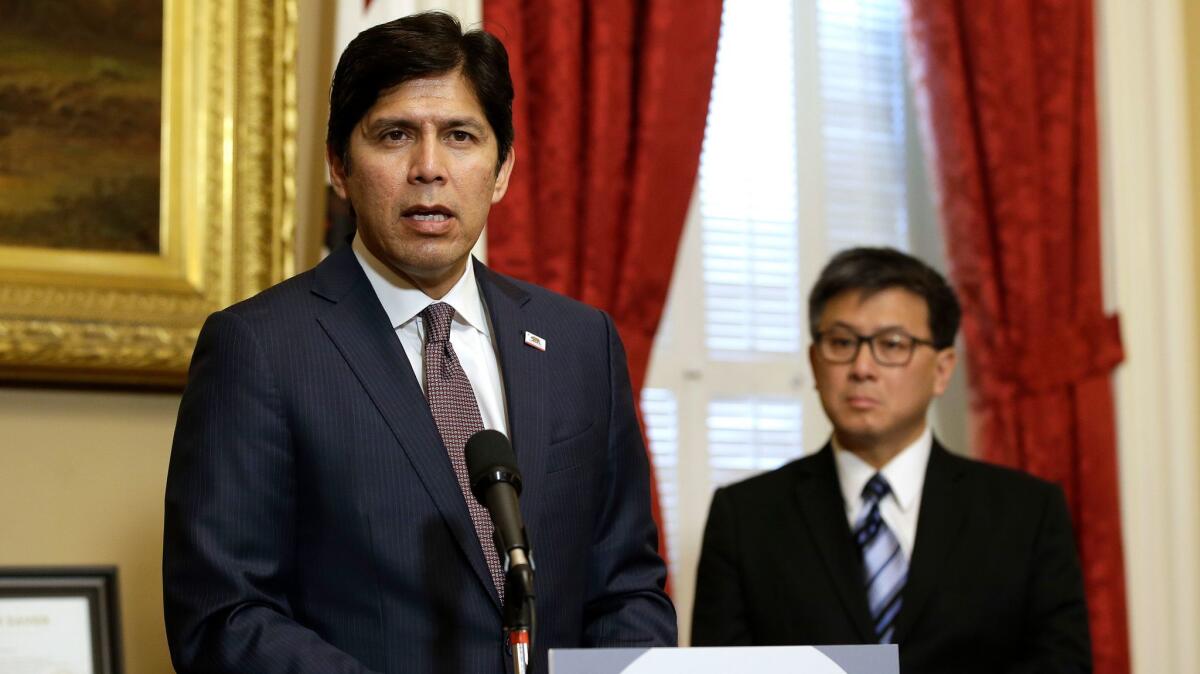State officials contend California private-sector retirement plan on firm legal ground

California officials vowed Thursday to implement a state-run retirement program that could benefit nearly 7 million private-sector workers despite recent congressional action that seeks to block it.
Senate leader Kevin de León and state Treasurer John Chiang said at a Sacramento news conference that the California Secure Choice program is on solid legal footing even though President Trump on Wednesday signed a House joint resolution that withdrew a federal regulation giving states explicit legal authority to have the programs.
“I am here to tell you that we are not backing down,” said De León (D-Los Angeles), who attributed the federal action to lobbying by a “handful of big banks” seeking to protect profits derived from managing private-sector retirement plans.
The program, which the Legislature enacted last year, is aimed at workers who are not offered a pension or 401(k) through work — an estimated 6.8 million in California and 39 million nationally. It is structured similarly to an individual retirement account without any employer contributions.
However, in an effort to maximize the number of workers who sign up for the program, it would allow workers to be automatically enrolled once they sign a form acknowledging they understand the program. Those who do not want to participate would have to “opt out.”
That provision was seen by some employer groups as potentially making the programs subject to the Employee Retirement Income Security Act, a 1974 law that regulates retirement plans and makes employers liable for prudently managing those plans.
De León and Chiang said that, as a courtesy to the California Chamber of Commerce and the California Manufacturers and Technology Assn., they lobbied for a regulation issued by the U.S. Department of Labor last year that excluded Secure Choice and similar plans being developed in other states from being subject to ERISA oversight.
“We did this as a favor to them,” Chiang said.
It was that Obama-era regulation that the House resolution nullified, but the two leaders contended that they thought Secure Choice could operate without the 2016 Labor Department rule.
“That was always our perspective from Day One,” De León said.
In support of their contention, the leaders released a legal opinion on the matter they sought from law firm K&L Gates. It concluded that guidance offered by the Department of Labor provided prior to 2016 offered employers legal “safe harbor” even if employees had to opt out of the program.
However, the opinion assumes that the bill establishing Secure Choice will be amended to exclude any reference to the 2016 Labor Department rule.
The California chamber later issued a statement saying that the retirement plan now appears to be “inconsistent with the existing statute which provides protection for employers from the threat of litigation.” The business group said it plans to seek an independent legal analysis on the matter.
State Sen. John Moorlach, (R-Costa Mesa), a member of the Standing Committee on Public Employment and Retirement, called the program a “noble effort” but urged that it be scrapped.
“Requiring employers to withhold contributions from their workers’ paychecks and send the funds to Sacramento to be invested on their behalf is highly inadvisable. In money management, there is rarely a scheme that has minimal costs and limited risk,” he said in a statement issued Thursday.
laurence.darmiento@latimes.com
Follow me: @ldarmiento
UPDATES:
3:25 p.m.: This article was updated with a comment from the California Chamber of Commerce.
2:15 p.m.: This article was updated with a comment from state Sen. John Moorlach.
This article was originally published at 1:40 p.m.







